business strategy
VerifiedAdded on 2023/01/18
|18
|4325
|81
AI Summary
hello ,please don t have more than 18 -20 plagiarism because last year i had some isuess with one asignement ,tnx
Contribute Materials
Your contribution can guide someone’s learning journey. Share your
documents today.
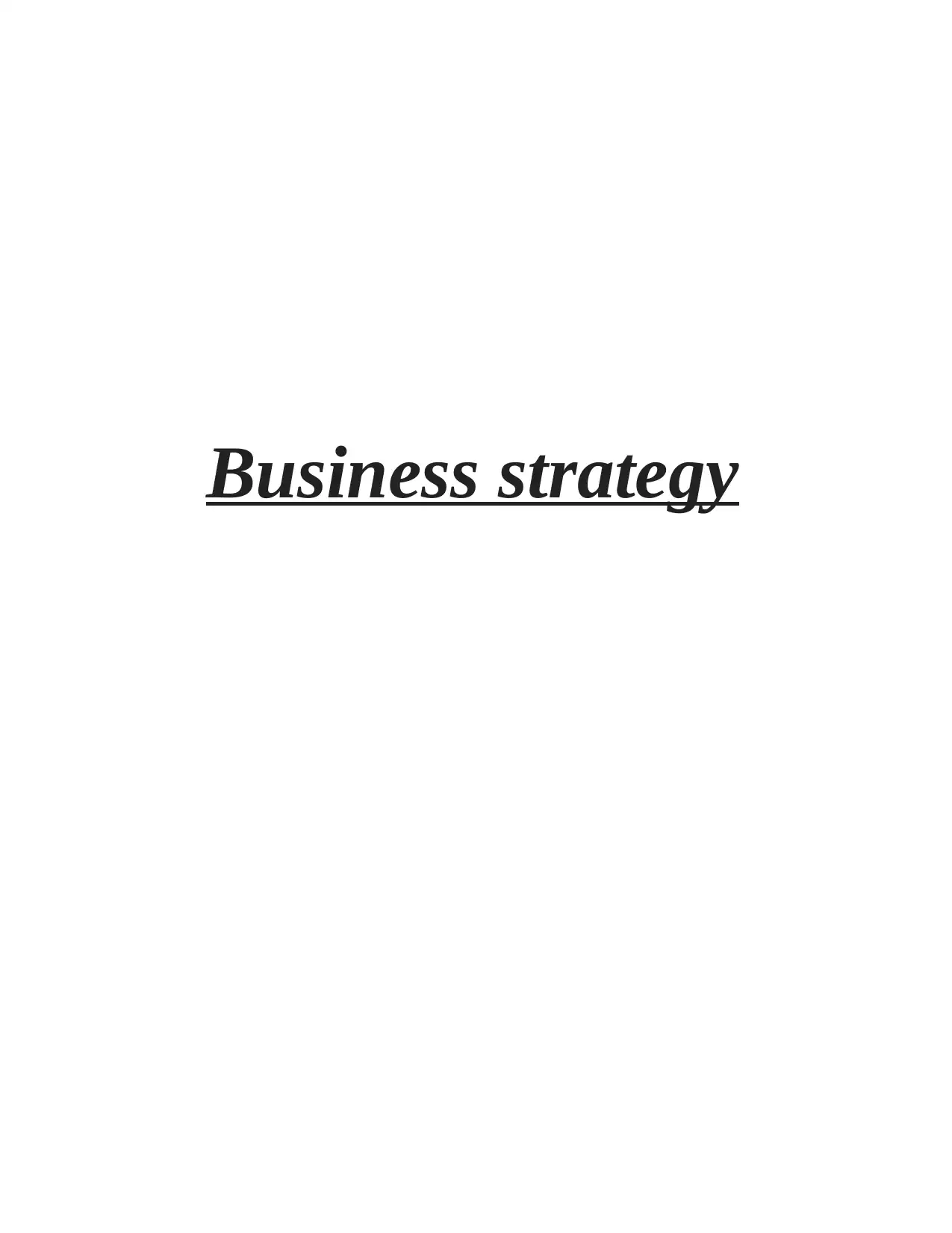
Business strategy
Secure Best Marks with AI Grader
Need help grading? Try our AI Grader for instant feedback on your assignments.

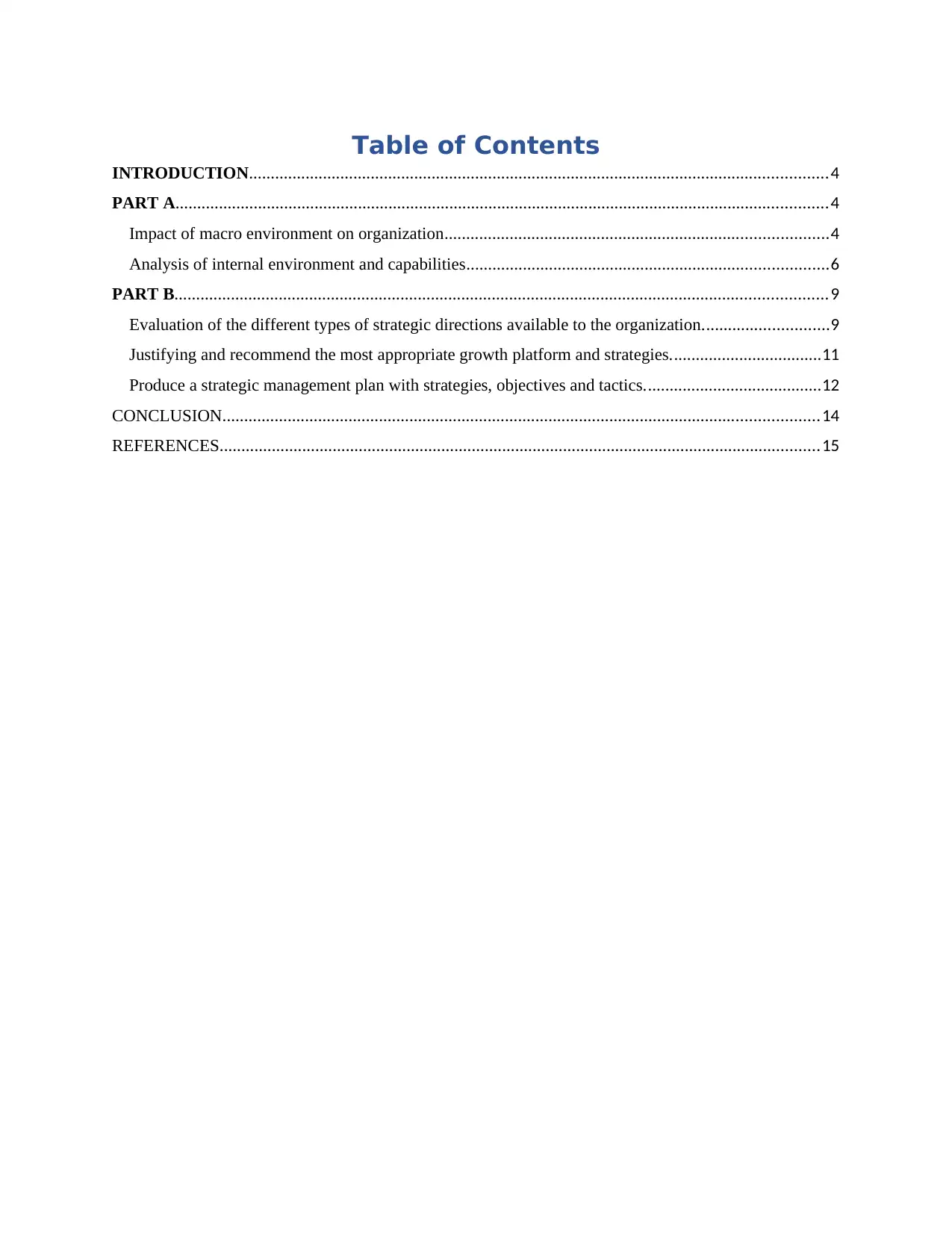
Table of Contents
INTRODUCTION.....................................................................................................................................4
PART A......................................................................................................................................................4
Impact of macro environment on organization........................................................................................4
Analysis of internal environment and capabilities...................................................................................6
PART B......................................................................................................................................................9
Evaluation of the different types of strategic directions available to the organization.............................9
Justifying and recommend the most appropriate growth platform and strategies...................................11
Produce a strategic management plan with strategies, objectives and tactics.........................................12
CONCLUSION.........................................................................................................................................14
REFERENCES..........................................................................................................................................15
INTRODUCTION.....................................................................................................................................4
PART A......................................................................................................................................................4
Impact of macro environment on organization........................................................................................4
Analysis of internal environment and capabilities...................................................................................6
PART B......................................................................................................................................................9
Evaluation of the different types of strategic directions available to the organization.............................9
Justifying and recommend the most appropriate growth platform and strategies...................................11
Produce a strategic management plan with strategies, objectives and tactics.........................................12
CONCLUSION.........................................................................................................................................14
REFERENCES..........................................................................................................................................15

Secure Best Marks with AI Grader
Need help grading? Try our AI Grader for instant feedback on your assignments.
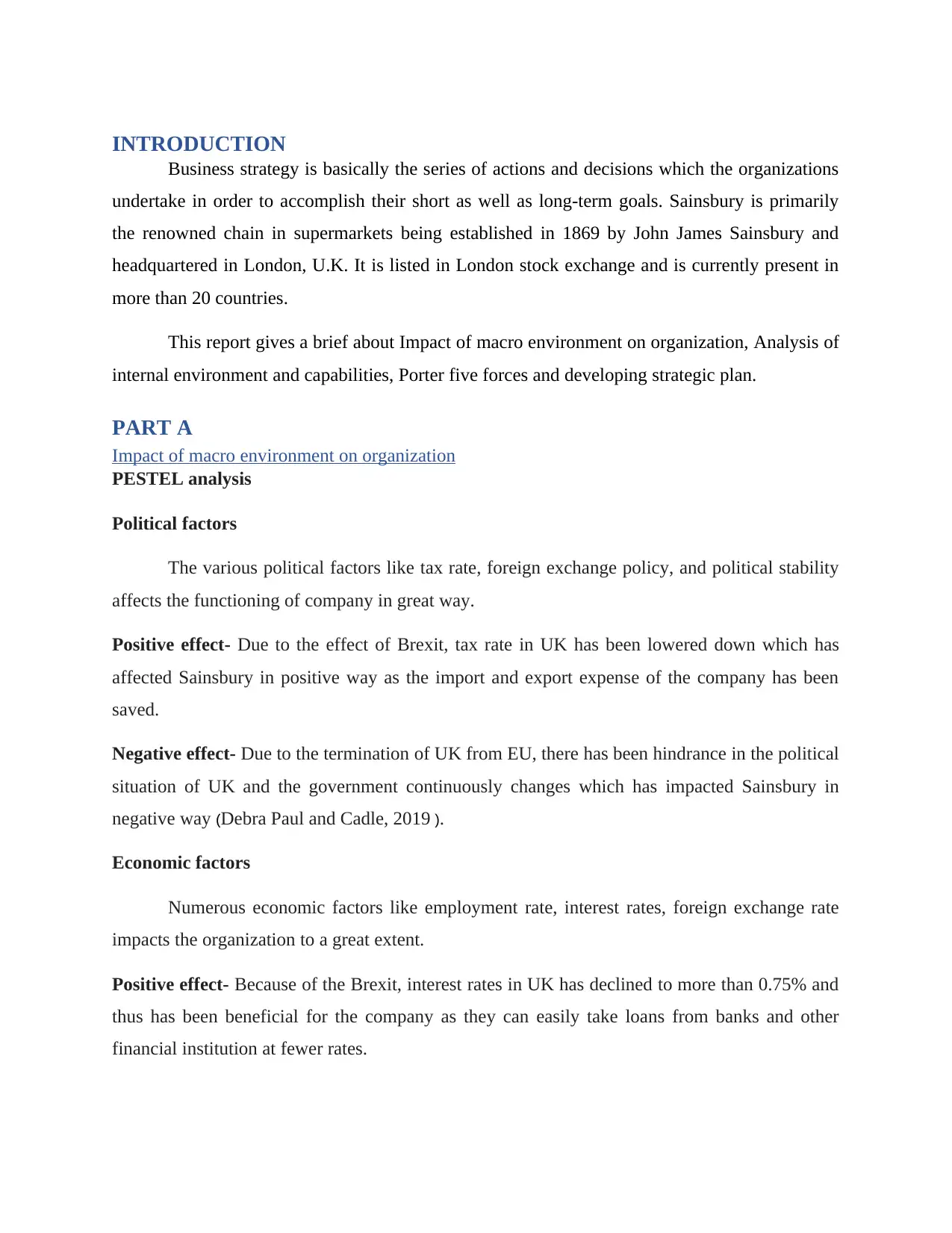
INTRODUCTION
Business strategy is basically the series of actions and decisions which the organizations
undertake in order to accomplish their short as well as long-term goals. Sainsbury is primarily
the renowned chain in supermarkets being established in 1869 by John James Sainsbury and
headquartered in London, U.K. It is listed in London stock exchange and is currently present in
more than 20 countries.
This report gives a brief about Impact of macro environment on organization, Analysis of
internal environment and capabilities, Porter five forces and developing strategic plan.
PART A
Impact of macro environment on organization
PESTEL analysis
Political factors
The various political factors like tax rate, foreign exchange policy, and political stability
affects the functioning of company in great way.
Positive effect- Due to the effect of Brexit, tax rate in UK has been lowered down which has
affected Sainsbury in positive way as the import and export expense of the company has been
saved.
Negative effect- Due to the termination of UK from EU, there has been hindrance in the political
situation of UK and the government continuously changes which has impacted Sainsbury in
negative way (Debra Paul and Cadle, 2019 ).
Economic factors
Numerous economic factors like employment rate, interest rates, foreign exchange rate
impacts the organization to a great extent.
Positive effect- Because of the Brexit, interest rates in UK has declined to more than 0.75% and
thus has been beneficial for the company as they can easily take loans from banks and other
financial institution at fewer rates.
Business strategy is basically the series of actions and decisions which the organizations
undertake in order to accomplish their short as well as long-term goals. Sainsbury is primarily
the renowned chain in supermarkets being established in 1869 by John James Sainsbury and
headquartered in London, U.K. It is listed in London stock exchange and is currently present in
more than 20 countries.
This report gives a brief about Impact of macro environment on organization, Analysis of
internal environment and capabilities, Porter five forces and developing strategic plan.
PART A
Impact of macro environment on organization
PESTEL analysis
Political factors
The various political factors like tax rate, foreign exchange policy, and political stability
affects the functioning of company in great way.
Positive effect- Due to the effect of Brexit, tax rate in UK has been lowered down which has
affected Sainsbury in positive way as the import and export expense of the company has been
saved.
Negative effect- Due to the termination of UK from EU, there has been hindrance in the political
situation of UK and the government continuously changes which has impacted Sainsbury in
negative way (Debra Paul and Cadle, 2019 ).
Economic factors
Numerous economic factors like employment rate, interest rates, foreign exchange rate
impacts the organization to a great extent.
Positive effect- Because of the Brexit, interest rates in UK has declined to more than 0.75% and
thus has been beneficial for the company as they can easily take loans from banks and other
financial institution at fewer rates.
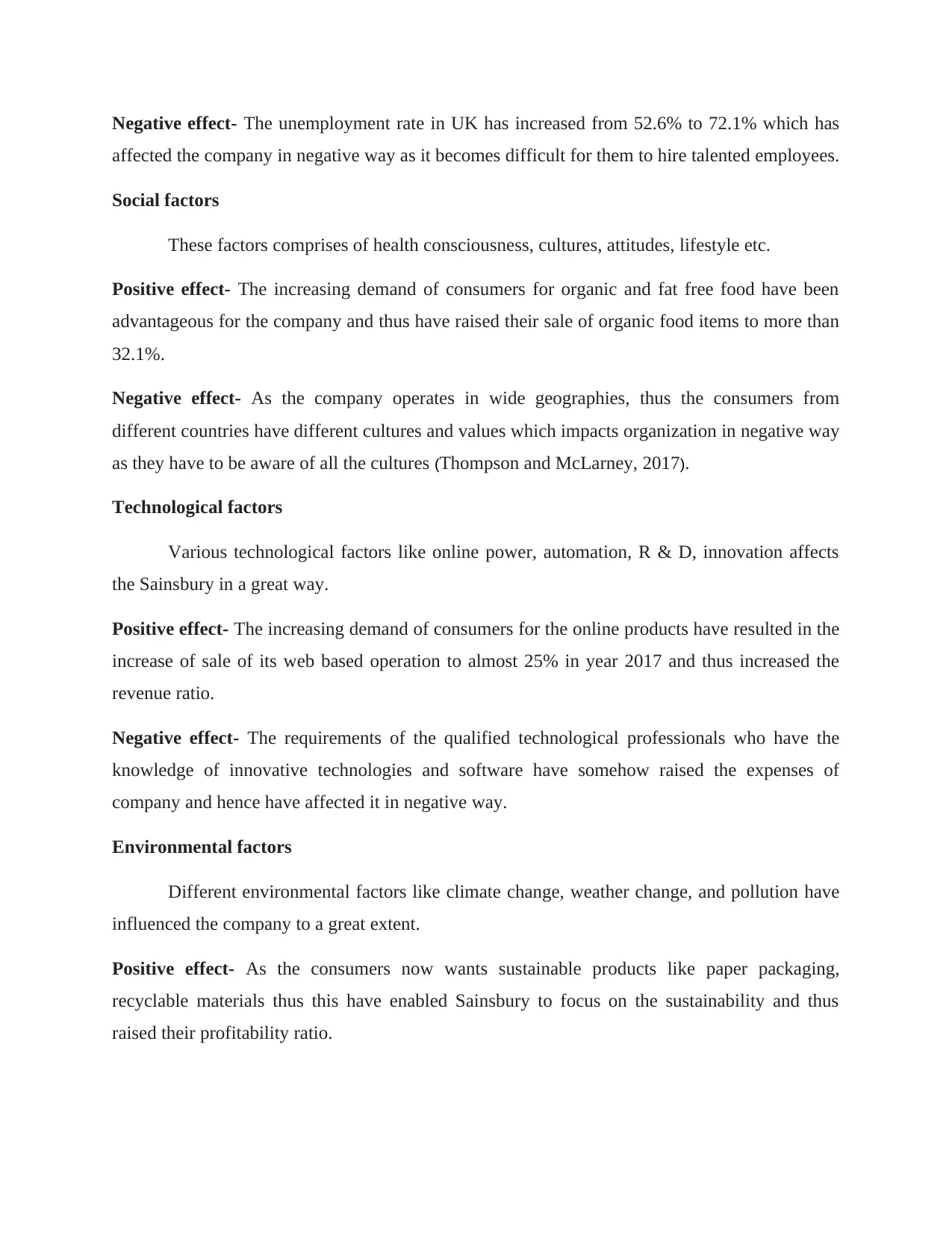
Negative effect- The unemployment rate in UK has increased from 52.6% to 72.1% which has
affected the company in negative way as it becomes difficult for them to hire talented employees.
Social factors
These factors comprises of health consciousness, cultures, attitudes, lifestyle etc.
Positive effect- The increasing demand of consumers for organic and fat free food have been
advantageous for the company and thus have raised their sale of organic food items to more than
32.1%.
Negative effect- As the company operates in wide geographies, thus the consumers from
different countries have different cultures and values which impacts organization in negative way
as they have to be aware of all the cultures (Thompson and McLarney, 2017).
Technological factors
Various technological factors like online power, automation, R & D, innovation affects
the Sainsbury in a great way.
Positive effect- The increasing demand of consumers for the online products have resulted in the
increase of sale of its web based operation to almost 25% in year 2017 and thus increased the
revenue ratio.
Negative effect- The requirements of the qualified technological professionals who have the
knowledge of innovative technologies and software have somehow raised the expenses of
company and hence have affected it in negative way.
Environmental factors
Different environmental factors like climate change, weather change, and pollution have
influenced the company to a great extent.
Positive effect- As the consumers now wants sustainable products like paper packaging,
recyclable materials thus this have enabled Sainsbury to focus on the sustainability and thus
raised their profitability ratio.
affected the company in negative way as it becomes difficult for them to hire talented employees.
Social factors
These factors comprises of health consciousness, cultures, attitudes, lifestyle etc.
Positive effect- The increasing demand of consumers for organic and fat free food have been
advantageous for the company and thus have raised their sale of organic food items to more than
32.1%.
Negative effect- As the company operates in wide geographies, thus the consumers from
different countries have different cultures and values which impacts organization in negative way
as they have to be aware of all the cultures (Thompson and McLarney, 2017).
Technological factors
Various technological factors like online power, automation, R & D, innovation affects
the Sainsbury in a great way.
Positive effect- The increasing demand of consumers for the online products have resulted in the
increase of sale of its web based operation to almost 25% in year 2017 and thus increased the
revenue ratio.
Negative effect- The requirements of the qualified technological professionals who have the
knowledge of innovative technologies and software have somehow raised the expenses of
company and hence have affected it in negative way.
Environmental factors
Different environmental factors like climate change, weather change, and pollution have
influenced the company to a great extent.
Positive effect- As the consumers now wants sustainable products like paper packaging,
recyclable materials thus this have enabled Sainsbury to focus on the sustainability and thus
raised their profitability ratio.
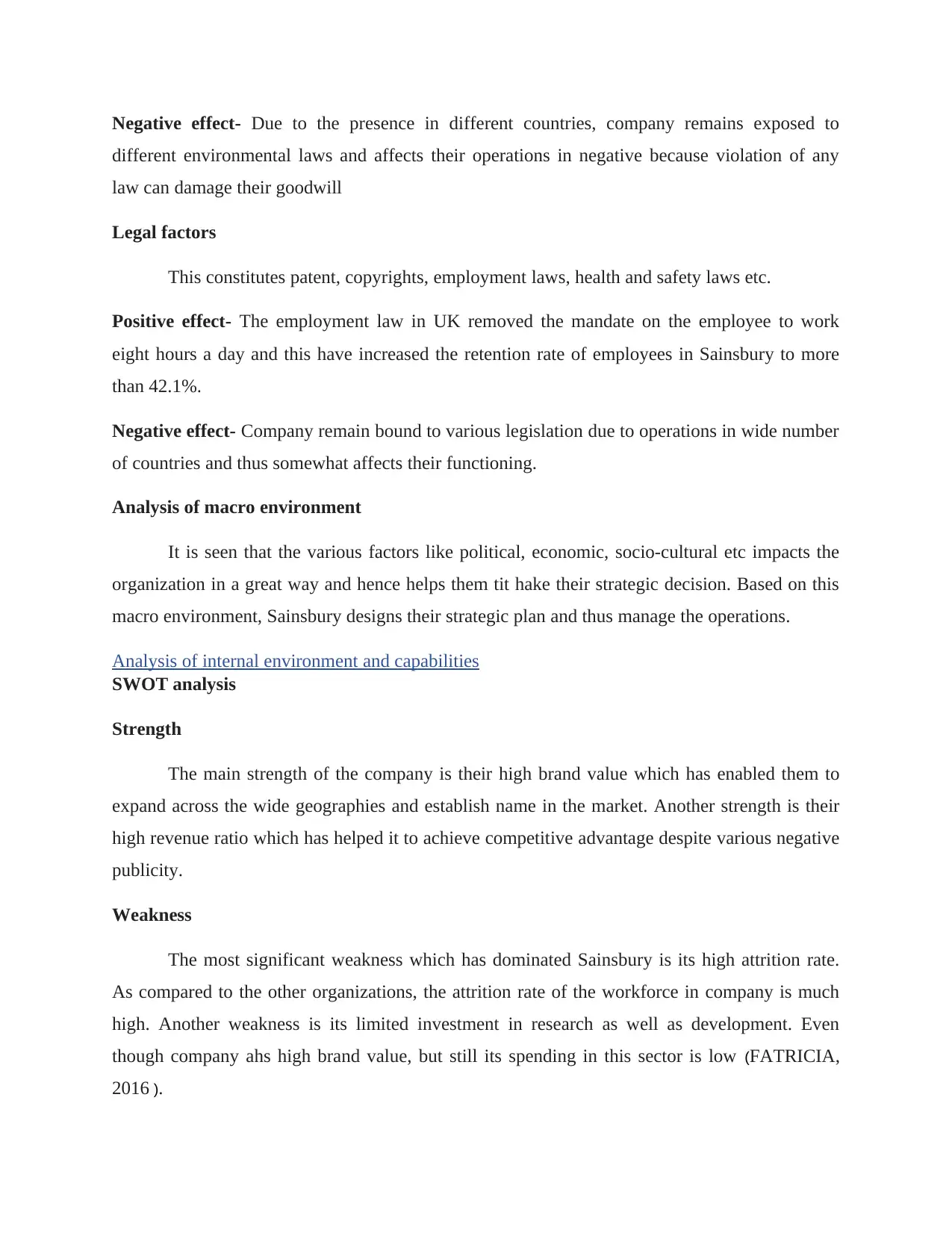
Negative effect- Due to the presence in different countries, company remains exposed to
different environmental laws and affects their operations in negative because violation of any
law can damage their goodwill
Legal factors
This constitutes patent, copyrights, employment laws, health and safety laws etc.
Positive effect- The employment law in UK removed the mandate on the employee to work
eight hours a day and this have increased the retention rate of employees in Sainsbury to more
than 42.1%.
Negative effect- Company remain bound to various legislation due to operations in wide number
of countries and thus somewhat affects their functioning.
Analysis of macro environment
It is seen that the various factors like political, economic, socio-cultural etc impacts the
organization in a great way and hence helps them tit hake their strategic decision. Based on this
macro environment, Sainsbury designs their strategic plan and thus manage the operations.
Analysis of internal environment and capabilities
SWOT analysis
Strength
The main strength of the company is their high brand value which has enabled them to
expand across the wide geographies and establish name in the market. Another strength is their
high revenue ratio which has helped it to achieve competitive advantage despite various negative
publicity.
Weakness
The most significant weakness which has dominated Sainsbury is its high attrition rate.
As compared to the other organizations, the attrition rate of the workforce in company is much
high. Another weakness is its limited investment in research as well as development. Even
though company ahs high brand value, but still its spending in this sector is low (FATRICIA,
2016 ).
different environmental laws and affects their operations in negative because violation of any
law can damage their goodwill
Legal factors
This constitutes patent, copyrights, employment laws, health and safety laws etc.
Positive effect- The employment law in UK removed the mandate on the employee to work
eight hours a day and this have increased the retention rate of employees in Sainsbury to more
than 42.1%.
Negative effect- Company remain bound to various legislation due to operations in wide number
of countries and thus somewhat affects their functioning.
Analysis of macro environment
It is seen that the various factors like political, economic, socio-cultural etc impacts the
organization in a great way and hence helps them tit hake their strategic decision. Based on this
macro environment, Sainsbury designs their strategic plan and thus manage the operations.
Analysis of internal environment and capabilities
SWOT analysis
Strength
The main strength of the company is their high brand value which has enabled them to
expand across the wide geographies and establish name in the market. Another strength is their
high revenue ratio which has helped it to achieve competitive advantage despite various negative
publicity.
Weakness
The most significant weakness which has dominated Sainsbury is its high attrition rate.
As compared to the other organizations, the attrition rate of the workforce in company is much
high. Another weakness is its limited investment in research as well as development. Even
though company ahs high brand value, but still its spending in this sector is low (FATRICIA,
2016 ).
Paraphrase This Document
Need a fresh take? Get an instant paraphrase of this document with our AI Paraphraser
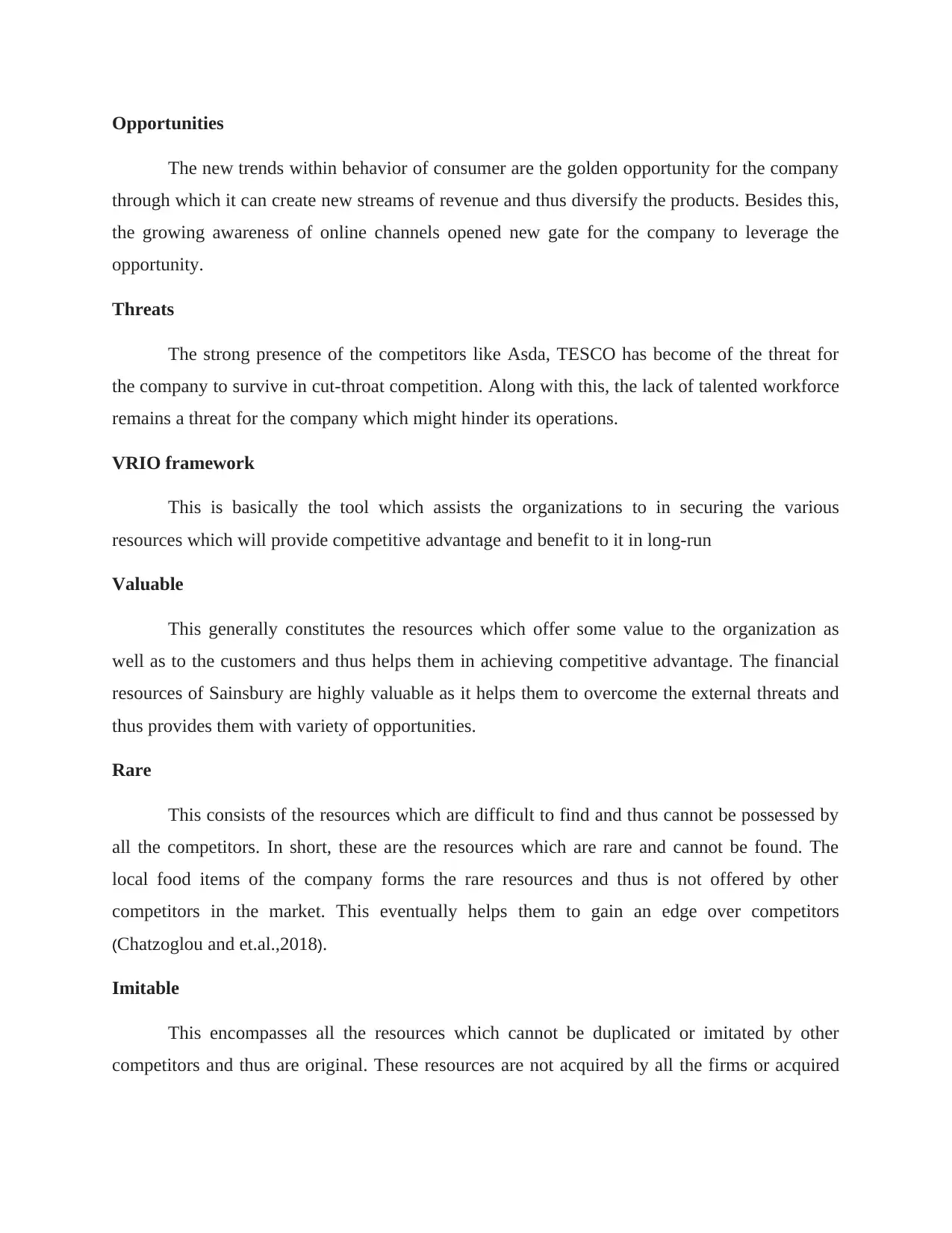
Opportunities
The new trends within behavior of consumer are the golden opportunity for the company
through which it can create new streams of revenue and thus diversify the products. Besides this,
the growing awareness of online channels opened new gate for the company to leverage the
opportunity.
Threats
The strong presence of the competitors like Asda, TESCO has become of the threat for
the company to survive in cut-throat competition. Along with this, the lack of talented workforce
remains a threat for the company which might hinder its operations.
VRIO framework
This is basically the tool which assists the organizations to in securing the various
resources which will provide competitive advantage and benefit to it in long-run
Valuable
This generally constitutes the resources which offer some value to the organization as
well as to the customers and thus helps them in achieving competitive advantage. The financial
resources of Sainsbury are highly valuable as it helps them to overcome the external threats and
thus provides them with variety of opportunities.
Rare
This consists of the resources which are difficult to find and thus cannot be possessed by
all the competitors. In short, these are the resources which are rare and cannot be found. The
local food items of the company forms the rare resources and thus is not offered by other
competitors in the market. This eventually helps them to gain an edge over competitors
(Chatzoglou and et.al.,2018).
Imitable
This encompasses all the resources which cannot be duplicated or imitated by other
competitors and thus are original. These resources are not acquired by all the firms or acquired
The new trends within behavior of consumer are the golden opportunity for the company
through which it can create new streams of revenue and thus diversify the products. Besides this,
the growing awareness of online channels opened new gate for the company to leverage the
opportunity.
Threats
The strong presence of the competitors like Asda, TESCO has become of the threat for
the company to survive in cut-throat competition. Along with this, the lack of talented workforce
remains a threat for the company which might hinder its operations.
VRIO framework
This is basically the tool which assists the organizations to in securing the various
resources which will provide competitive advantage and benefit to it in long-run
Valuable
This generally constitutes the resources which offer some value to the organization as
well as to the customers and thus helps them in achieving competitive advantage. The financial
resources of Sainsbury are highly valuable as it helps them to overcome the external threats and
thus provides them with variety of opportunities.
Rare
This consists of the resources which are difficult to find and thus cannot be possessed by
all the competitors. In short, these are the resources which are rare and cannot be found. The
local food items of the company forms the rare resources and thus is not offered by other
competitors in the market. This eventually helps them to gain an edge over competitors
(Chatzoglou and et.al.,2018).
Imitable
This encompasses all the resources which cannot be duplicated or imitated by other
competitors and thus are original. These resources are not acquired by all the firms or acquired
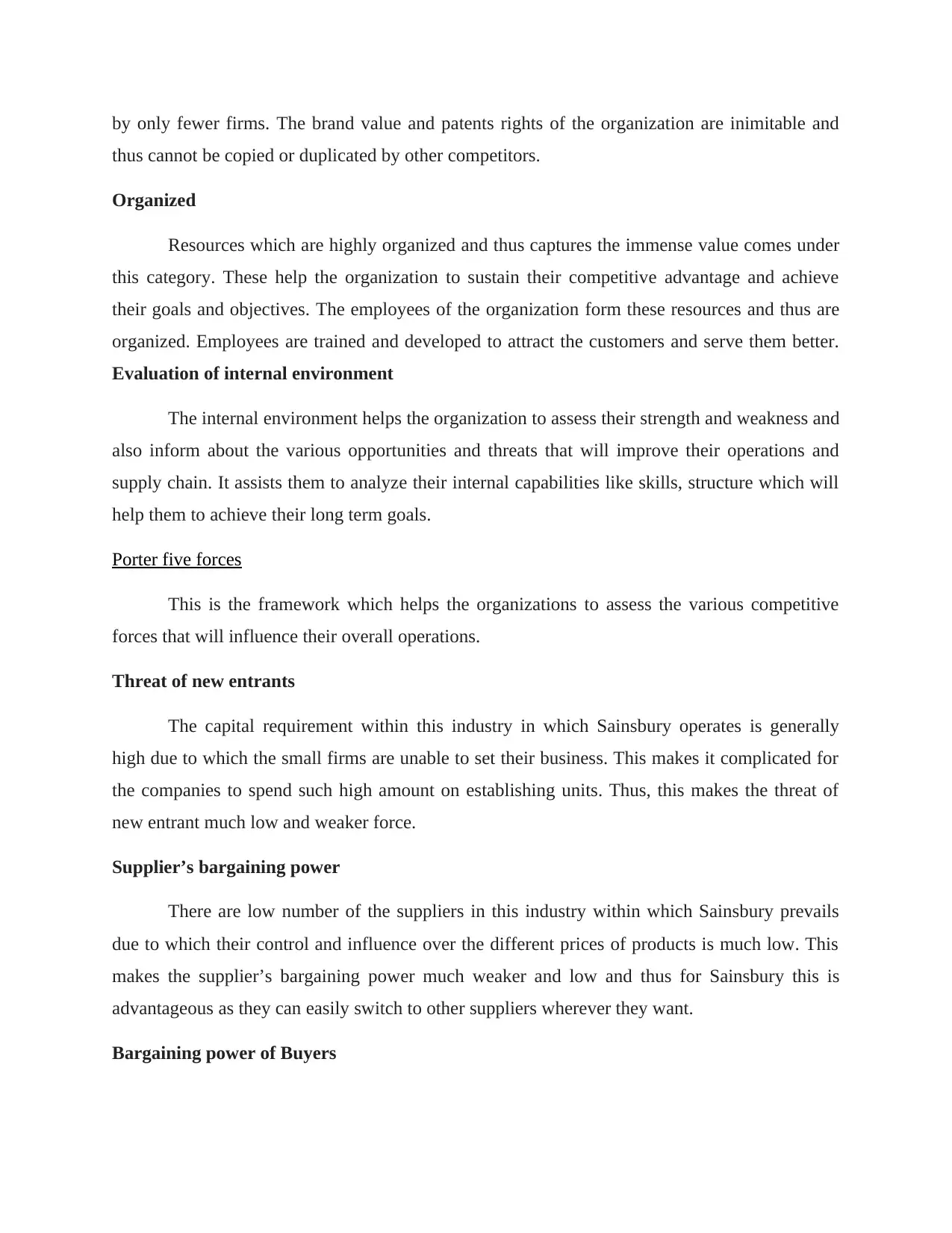
by only fewer firms. The brand value and patents rights of the organization are inimitable and
thus cannot be copied or duplicated by other competitors.
Organized
Resources which are highly organized and thus captures the immense value comes under
this category. These help the organization to sustain their competitive advantage and achieve
their goals and objectives. The employees of the organization form these resources and thus are
organized. Employees are trained and developed to attract the customers and serve them better.
Evaluation of internal environment
The internal environment helps the organization to assess their strength and weakness and
also inform about the various opportunities and threats that will improve their operations and
supply chain. It assists them to analyze their internal capabilities like skills, structure which will
help them to achieve their long term goals.
Porter five forces
This is the framework which helps the organizations to assess the various competitive
forces that will influence their overall operations.
Threat of new entrants
The capital requirement within this industry in which Sainsbury operates is generally
high due to which the small firms are unable to set their business. This makes it complicated for
the companies to spend such high amount on establishing units. Thus, this makes the threat of
new entrant much low and weaker force.
Supplier’s bargaining power
There are low number of the suppliers in this industry within which Sainsbury prevails
due to which their control and influence over the different prices of products is much low. This
makes the supplier’s bargaining power much weaker and low and thus for Sainsbury this is
advantageous as they can easily switch to other suppliers wherever they want.
Bargaining power of Buyers
thus cannot be copied or duplicated by other competitors.
Organized
Resources which are highly organized and thus captures the immense value comes under
this category. These help the organization to sustain their competitive advantage and achieve
their goals and objectives. The employees of the organization form these resources and thus are
organized. Employees are trained and developed to attract the customers and serve them better.
Evaluation of internal environment
The internal environment helps the organization to assess their strength and weakness and
also inform about the various opportunities and threats that will improve their operations and
supply chain. It assists them to analyze their internal capabilities like skills, structure which will
help them to achieve their long term goals.
Porter five forces
This is the framework which helps the organizations to assess the various competitive
forces that will influence their overall operations.
Threat of new entrants
The capital requirement within this industry in which Sainsbury operates is generally
high due to which the small firms are unable to set their business. This makes it complicated for
the companies to spend such high amount on establishing units. Thus, this makes the threat of
new entrant much low and weaker force.
Supplier’s bargaining power
There are low number of the suppliers in this industry within which Sainsbury prevails
due to which their control and influence over the different prices of products is much low. This
makes the supplier’s bargaining power much weaker and low and thus for Sainsbury this is
advantageous as they can easily switch to other suppliers wherever they want.
Bargaining power of Buyers
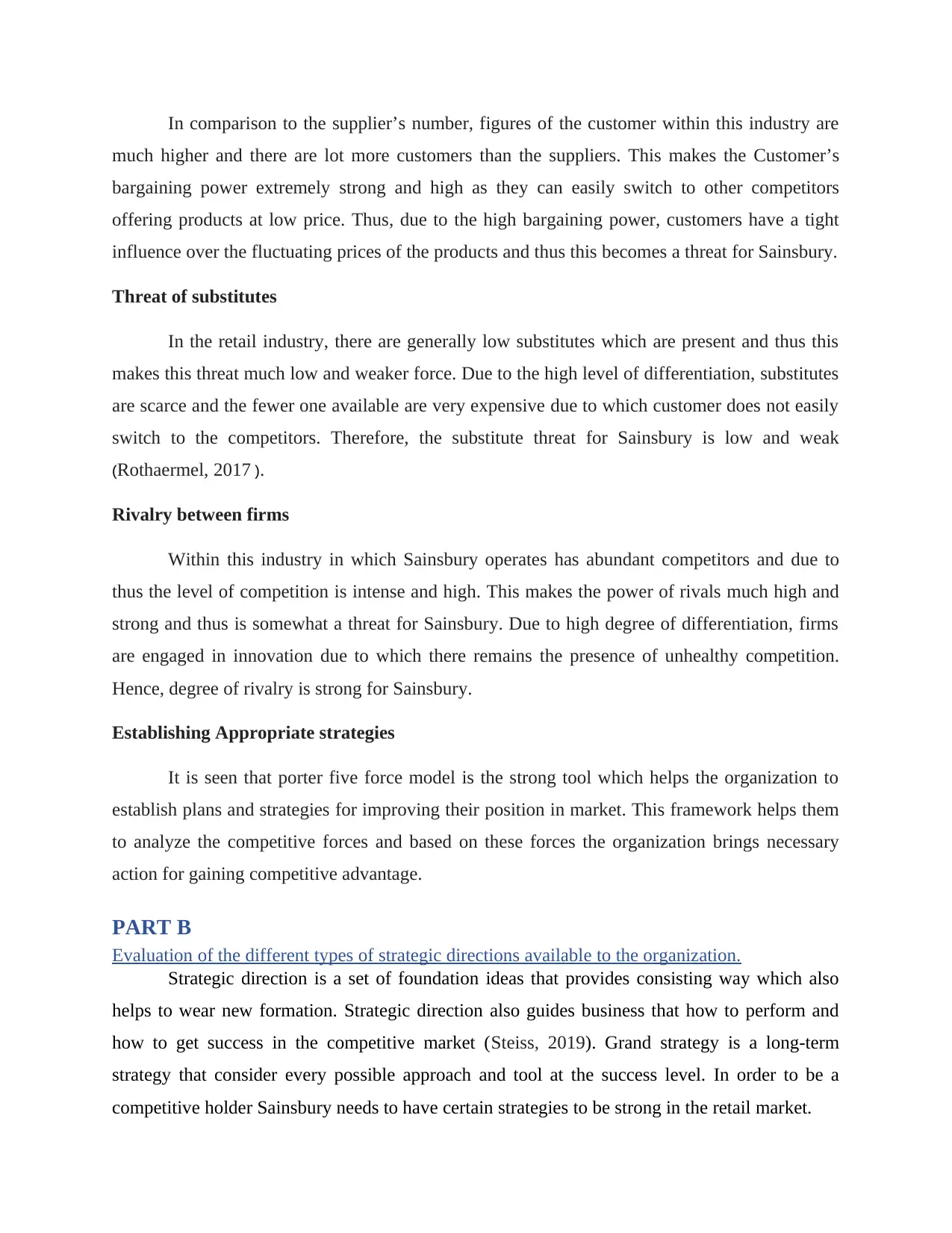
In comparison to the supplier’s number, figures of the customer within this industry are
much higher and there are lot more customers than the suppliers. This makes the Customer’s
bargaining power extremely strong and high as they can easily switch to other competitors
offering products at low price. Thus, due to the high bargaining power, customers have a tight
influence over the fluctuating prices of the products and thus this becomes a threat for Sainsbury.
Threat of substitutes
In the retail industry, there are generally low substitutes which are present and thus this
makes this threat much low and weaker force. Due to the high level of differentiation, substitutes
are scarce and the fewer one available are very expensive due to which customer does not easily
switch to the competitors. Therefore, the substitute threat for Sainsbury is low and weak
(Rothaermel, 2017 ).
Rivalry between firms
Within this industry in which Sainsbury operates has abundant competitors and due to
thus the level of competition is intense and high. This makes the power of rivals much high and
strong and thus is somewhat a threat for Sainsbury. Due to high degree of differentiation, firms
are engaged in innovation due to which there remains the presence of unhealthy competition.
Hence, degree of rivalry is strong for Sainsbury.
Establishing Appropriate strategies
It is seen that porter five force model is the strong tool which helps the organization to
establish plans and strategies for improving their position in market. This framework helps them
to analyze the competitive forces and based on these forces the organization brings necessary
action for gaining competitive advantage.
PART B
Evaluation of the different types of strategic directions available to the organization.
Strategic direction is a set of foundation ideas that provides consisting way which also
helps to wear new formation. Strategic direction also guides business that how to perform and
how to get success in the competitive market (Steiss, 2019). Grand strategy is a long-term
strategy that consider every possible approach and tool at the success level. In order to be a
competitive holder Sainsbury needs to have certain strategies to be strong in the retail market.
much higher and there are lot more customers than the suppliers. This makes the Customer’s
bargaining power extremely strong and high as they can easily switch to other competitors
offering products at low price. Thus, due to the high bargaining power, customers have a tight
influence over the fluctuating prices of the products and thus this becomes a threat for Sainsbury.
Threat of substitutes
In the retail industry, there are generally low substitutes which are present and thus this
makes this threat much low and weaker force. Due to the high level of differentiation, substitutes
are scarce and the fewer one available are very expensive due to which customer does not easily
switch to the competitors. Therefore, the substitute threat for Sainsbury is low and weak
(Rothaermel, 2017 ).
Rivalry between firms
Within this industry in which Sainsbury operates has abundant competitors and due to
thus the level of competition is intense and high. This makes the power of rivals much high and
strong and thus is somewhat a threat for Sainsbury. Due to high degree of differentiation, firms
are engaged in innovation due to which there remains the presence of unhealthy competition.
Hence, degree of rivalry is strong for Sainsbury.
Establishing Appropriate strategies
It is seen that porter five force model is the strong tool which helps the organization to
establish plans and strategies for improving their position in market. This framework helps them
to analyze the competitive forces and based on these forces the organization brings necessary
action for gaining competitive advantage.
PART B
Evaluation of the different types of strategic directions available to the organization.
Strategic direction is a set of foundation ideas that provides consisting way which also
helps to wear new formation. Strategic direction also guides business that how to perform and
how to get success in the competitive market (Steiss, 2019). Grand strategy is a long-term
strategy that consider every possible approach and tool at the success level. In order to be a
competitive holder Sainsbury needs to have certain strategies to be strong in the retail market.
Secure Best Marks with AI Grader
Need help grading? Try our AI Grader for instant feedback on your assignments.
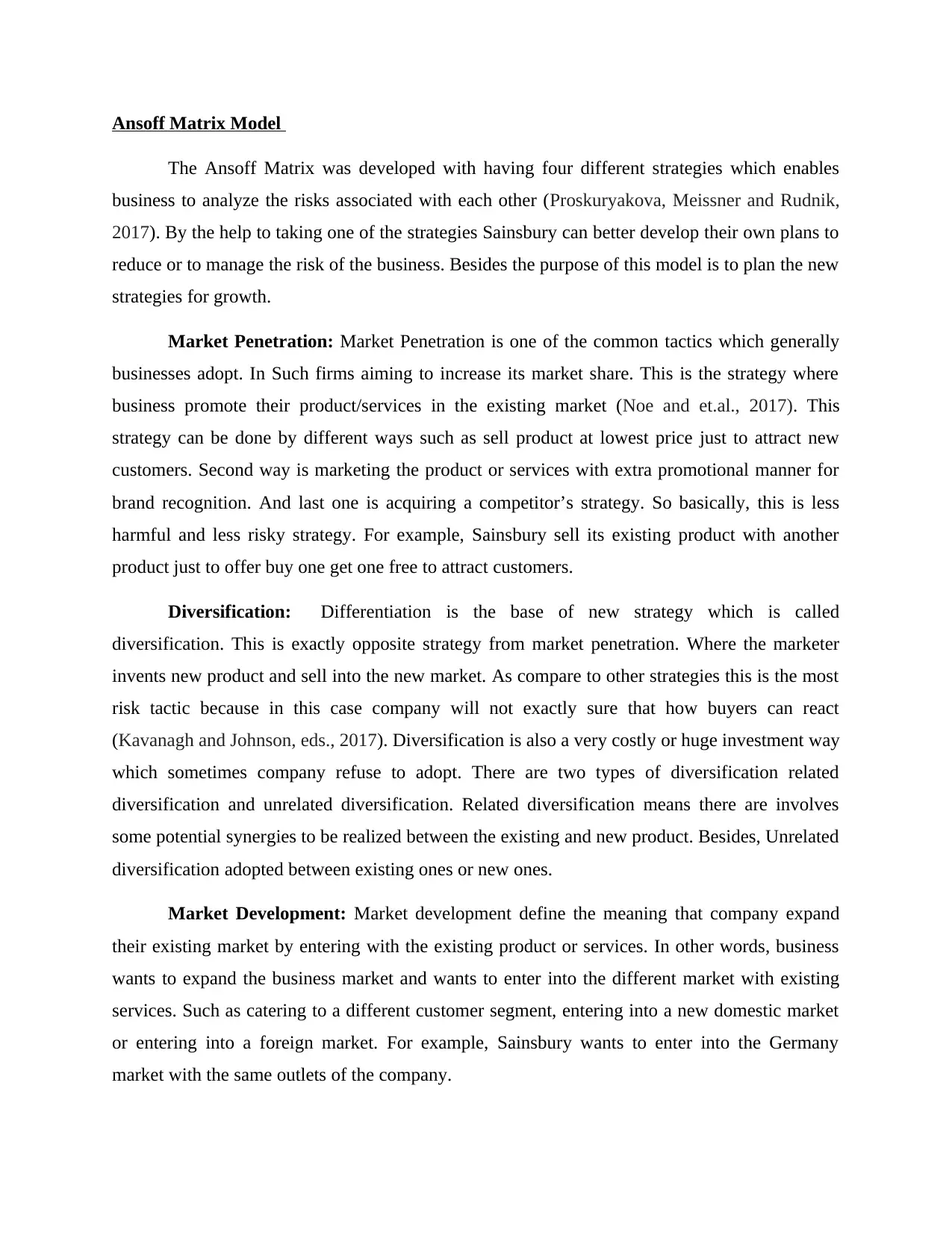
Ansoff Matrix Model
The Ansoff Matrix was developed with having four different strategies which enables
business to analyze the risks associated with each other (Proskuryakova, Meissner and Rudnik,
2017). By the help to taking one of the strategies Sainsbury can better develop their own plans to
reduce or to manage the risk of the business. Besides the purpose of this model is to plan the new
strategies for growth.
Market Penetration: Market Penetration is one of the common tactics which generally
businesses adopt. In Such firms aiming to increase its market share. This is the strategy where
business promote their product/services in the existing market (Noe and et.al., 2017). This
strategy can be done by different ways such as sell product at lowest price just to attract new
customers. Second way is marketing the product or services with extra promotional manner for
brand recognition. And last one is acquiring a competitor’s strategy. So basically, this is less
harmful and less risky strategy. For example, Sainsbury sell its existing product with another
product just to offer buy one get one free to attract customers.
Diversification: Differentiation is the base of new strategy which is called
diversification. This is exactly opposite strategy from market penetration. Where the marketer
invents new product and sell into the new market. As compare to other strategies this is the most
risk tactic because in this case company will not exactly sure that how buyers can react
(Kavanagh and Johnson, eds., 2017). Diversification is also a very costly or huge investment way
which sometimes company refuse to adopt. There are two types of diversification related
diversification and unrelated diversification. Related diversification means there are involves
some potential synergies to be realized between the existing and new product. Besides, Unrelated
diversification adopted between existing ones or new ones.
Market Development: Market development define the meaning that company expand
their existing market by entering with the existing product or services. In other words, business
wants to expand the business market and wants to enter into the different market with existing
services. Such as catering to a different customer segment, entering into a new domestic market
or entering into a foreign market. For example, Sainsbury wants to enter into the Germany
market with the same outlets of the company.
The Ansoff Matrix was developed with having four different strategies which enables
business to analyze the risks associated with each other (Proskuryakova, Meissner and Rudnik,
2017). By the help to taking one of the strategies Sainsbury can better develop their own plans to
reduce or to manage the risk of the business. Besides the purpose of this model is to plan the new
strategies for growth.
Market Penetration: Market Penetration is one of the common tactics which generally
businesses adopt. In Such firms aiming to increase its market share. This is the strategy where
business promote their product/services in the existing market (Noe and et.al., 2017). This
strategy can be done by different ways such as sell product at lowest price just to attract new
customers. Second way is marketing the product or services with extra promotional manner for
brand recognition. And last one is acquiring a competitor’s strategy. So basically, this is less
harmful and less risky strategy. For example, Sainsbury sell its existing product with another
product just to offer buy one get one free to attract customers.
Diversification: Differentiation is the base of new strategy which is called
diversification. This is exactly opposite strategy from market penetration. Where the marketer
invents new product and sell into the new market. As compare to other strategies this is the most
risk tactic because in this case company will not exactly sure that how buyers can react
(Kavanagh and Johnson, eds., 2017). Diversification is also a very costly or huge investment way
which sometimes company refuse to adopt. There are two types of diversification related
diversification and unrelated diversification. Related diversification means there are involves
some potential synergies to be realized between the existing and new product. Besides, Unrelated
diversification adopted between existing ones or new ones.
Market Development: Market development define the meaning that company expand
their existing market by entering with the existing product or services. In other words, business
wants to expand the business market and wants to enter into the different market with existing
services. Such as catering to a different customer segment, entering into a new domestic market
or entering into a foreign market. For example, Sainsbury wants to enter into the Germany
market with the same outlets of the company.
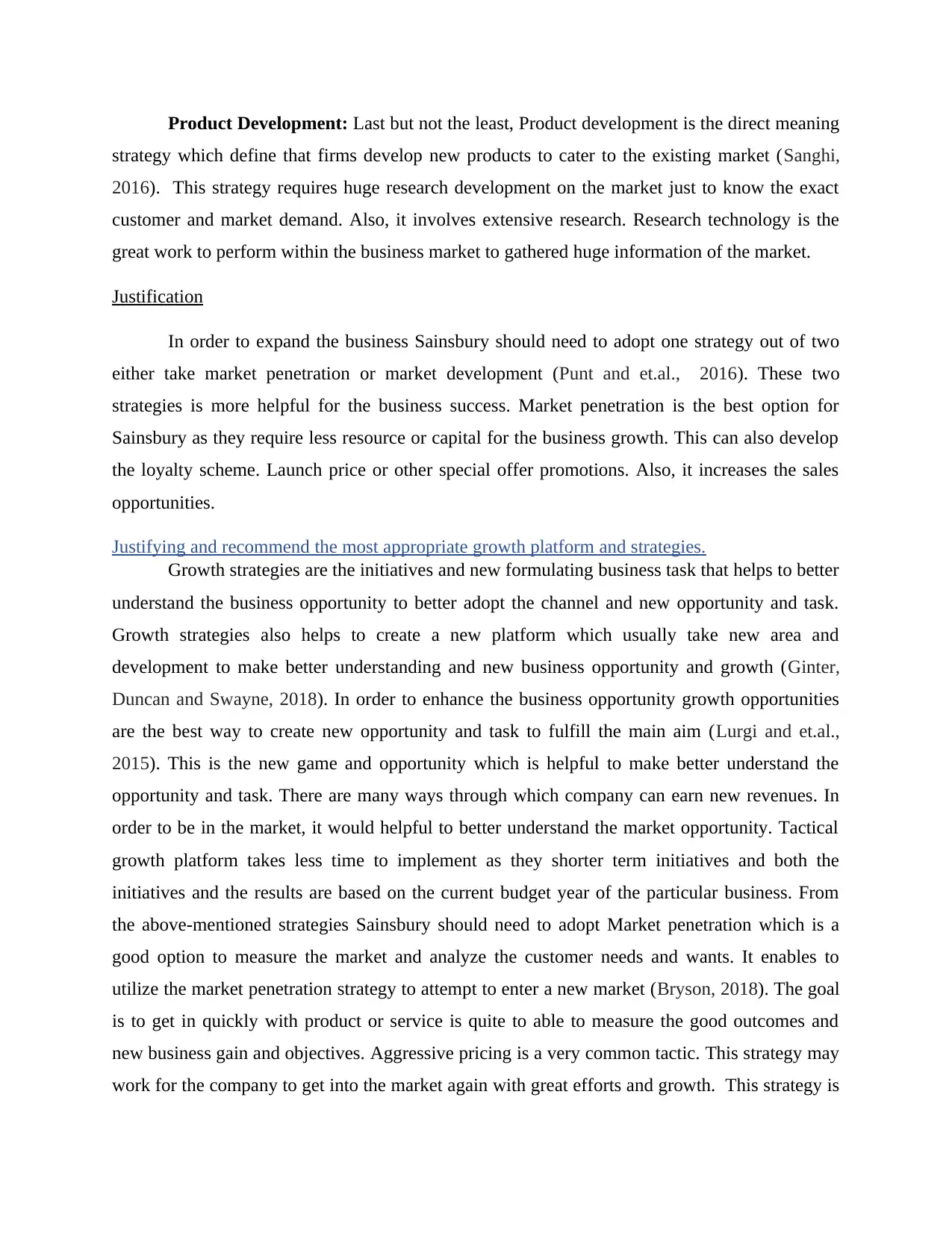
Product Development: Last but not the least, Product development is the direct meaning
strategy which define that firms develop new products to cater to the existing market (Sanghi,
2016). This strategy requires huge research development on the market just to know the exact
customer and market demand. Also, it involves extensive research. Research technology is the
great work to perform within the business market to gathered huge information of the market.
Justification
In order to expand the business Sainsbury should need to adopt one strategy out of two
either take market penetration or market development (Punt and et.al., 2016). These two
strategies is more helpful for the business success. Market penetration is the best option for
Sainsbury as they require less resource or capital for the business growth. This can also develop
the loyalty scheme. Launch price or other special offer promotions. Also, it increases the sales
opportunities.
Justifying and recommend the most appropriate growth platform and strategies.
Growth strategies are the initiatives and new formulating business task that helps to better
understand the business opportunity to better adopt the channel and new opportunity and task.
Growth strategies also helps to create a new platform which usually take new area and
development to make better understanding and new business opportunity and growth (Ginter,
Duncan and Swayne, 2018). In order to enhance the business opportunity growth opportunities
are the best way to create new opportunity and task to fulfill the main aim (Lurgi and et.al.,
2015). This is the new game and opportunity which is helpful to make better understand the
opportunity and task. There are many ways through which company can earn new revenues. In
order to be in the market, it would helpful to better understand the market opportunity. Tactical
growth platform takes less time to implement as they shorter term initiatives and both the
initiatives and the results are based on the current budget year of the particular business. From
the above-mentioned strategies Sainsbury should need to adopt Market penetration which is a
good option to measure the market and analyze the customer needs and wants. It enables to
utilize the market penetration strategy to attempt to enter a new market (Bryson, 2018). The goal
is to get in quickly with product or service is quite to able to measure the good outcomes and
new business gain and objectives. Aggressive pricing is a very common tactic. This strategy may
work for the company to get into the market again with great efforts and growth. This strategy is
strategy which define that firms develop new products to cater to the existing market (Sanghi,
2016). This strategy requires huge research development on the market just to know the exact
customer and market demand. Also, it involves extensive research. Research technology is the
great work to perform within the business market to gathered huge information of the market.
Justification
In order to expand the business Sainsbury should need to adopt one strategy out of two
either take market penetration or market development (Punt and et.al., 2016). These two
strategies is more helpful for the business success. Market penetration is the best option for
Sainsbury as they require less resource or capital for the business growth. This can also develop
the loyalty scheme. Launch price or other special offer promotions. Also, it increases the sales
opportunities.
Justifying and recommend the most appropriate growth platform and strategies.
Growth strategies are the initiatives and new formulating business task that helps to better
understand the business opportunity to better adopt the channel and new opportunity and task.
Growth strategies also helps to create a new platform which usually take new area and
development to make better understanding and new business opportunity and growth (Ginter,
Duncan and Swayne, 2018). In order to enhance the business opportunity growth opportunities
are the best way to create new opportunity and task to fulfill the main aim (Lurgi and et.al.,
2015). This is the new game and opportunity which is helpful to make better understand the
opportunity and task. There are many ways through which company can earn new revenues. In
order to be in the market, it would helpful to better understand the market opportunity. Tactical
growth platform takes less time to implement as they shorter term initiatives and both the
initiatives and the results are based on the current budget year of the particular business. From
the above-mentioned strategies Sainsbury should need to adopt Market penetration which is a
good option to measure the market and analyze the customer needs and wants. It enables to
utilize the market penetration strategy to attempt to enter a new market (Bryson, 2018). The goal
is to get in quickly with product or service is quite to able to measure the good outcomes and
new business gain and objectives. Aggressive pricing is a very common tactic. This strategy may
work for the company to get into the market again with great efforts and growth. This strategy is
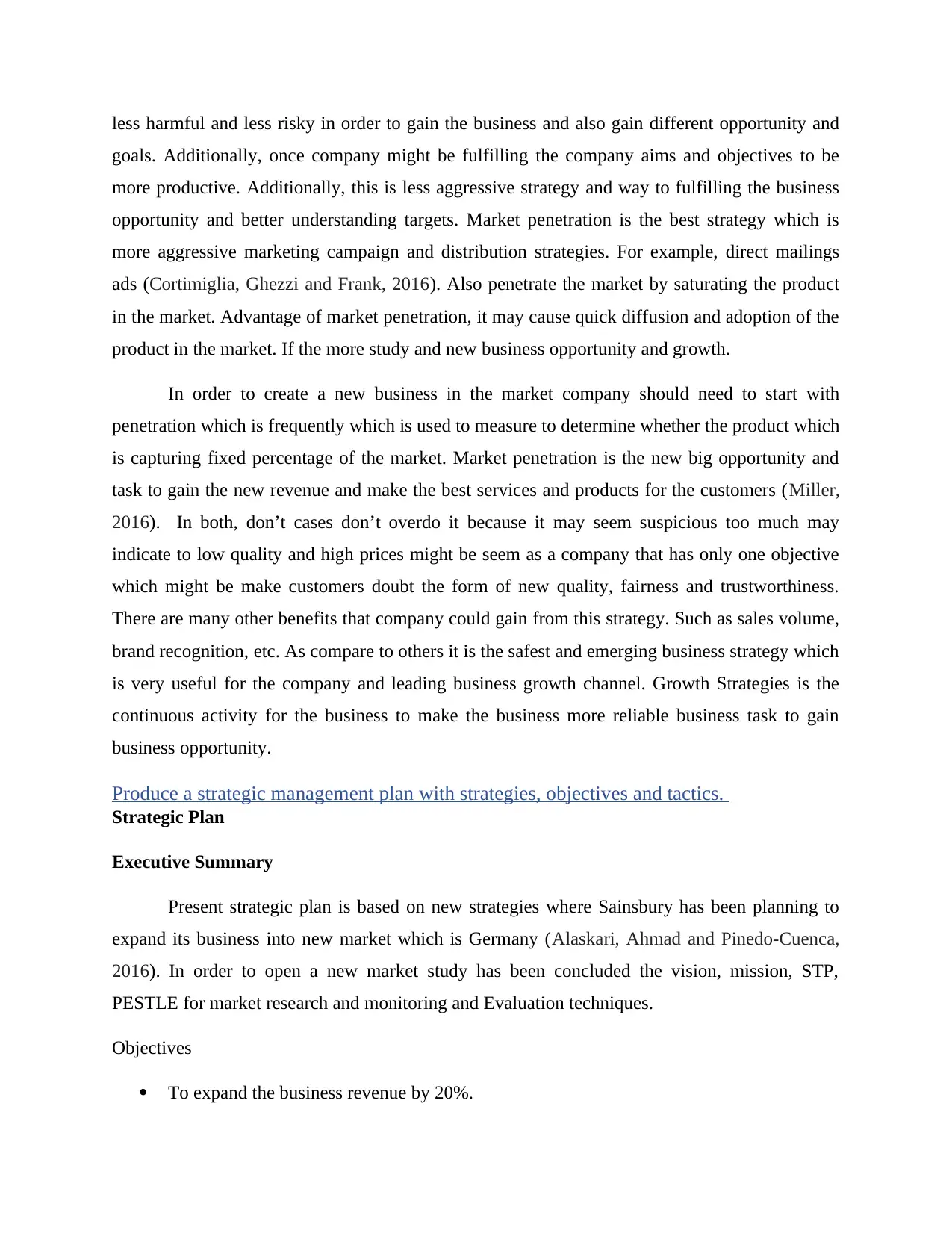
less harmful and less risky in order to gain the business and also gain different opportunity and
goals. Additionally, once company might be fulfilling the company aims and objectives to be
more productive. Additionally, this is less aggressive strategy and way to fulfilling the business
opportunity and better understanding targets. Market penetration is the best strategy which is
more aggressive marketing campaign and distribution strategies. For example, direct mailings
ads (Cortimiglia, Ghezzi and Frank, 2016). Also penetrate the market by saturating the product
in the market. Advantage of market penetration, it may cause quick diffusion and adoption of the
product in the market. If the more study and new business opportunity and growth.
In order to create a new business in the market company should need to start with
penetration which is frequently which is used to measure to determine whether the product which
is capturing fixed percentage of the market. Market penetration is the new big opportunity and
task to gain the new revenue and make the best services and products for the customers (Miller,
2016). In both, don’t cases don’t overdo it because it may seem suspicious too much may
indicate to low quality and high prices might be seem as a company that has only one objective
which might be make customers doubt the form of new quality, fairness and trustworthiness.
There are many other benefits that company could gain from this strategy. Such as sales volume,
brand recognition, etc. As compare to others it is the safest and emerging business strategy which
is very useful for the company and leading business growth channel. Growth Strategies is the
continuous activity for the business to make the business more reliable business task to gain
business opportunity.
Produce a strategic management plan with strategies, objectives and tactics.
Strategic Plan
Executive Summary
Present strategic plan is based on new strategies where Sainsbury has been planning to
expand its business into new market which is Germany (Alaskari, Ahmad and Pinedo-Cuenca,
2016). In order to open a new market study has been concluded the vision, mission, STP,
PESTLE for market research and monitoring and Evaluation techniques.
Objectives
To expand the business revenue by 20%.
goals. Additionally, once company might be fulfilling the company aims and objectives to be
more productive. Additionally, this is less aggressive strategy and way to fulfilling the business
opportunity and better understanding targets. Market penetration is the best strategy which is
more aggressive marketing campaign and distribution strategies. For example, direct mailings
ads (Cortimiglia, Ghezzi and Frank, 2016). Also penetrate the market by saturating the product
in the market. Advantage of market penetration, it may cause quick diffusion and adoption of the
product in the market. If the more study and new business opportunity and growth.
In order to create a new business in the market company should need to start with
penetration which is frequently which is used to measure to determine whether the product which
is capturing fixed percentage of the market. Market penetration is the new big opportunity and
task to gain the new revenue and make the best services and products for the customers (Miller,
2016). In both, don’t cases don’t overdo it because it may seem suspicious too much may
indicate to low quality and high prices might be seem as a company that has only one objective
which might be make customers doubt the form of new quality, fairness and trustworthiness.
There are many other benefits that company could gain from this strategy. Such as sales volume,
brand recognition, etc. As compare to others it is the safest and emerging business strategy which
is very useful for the company and leading business growth channel. Growth Strategies is the
continuous activity for the business to make the business more reliable business task to gain
business opportunity.
Produce a strategic management plan with strategies, objectives and tactics.
Strategic Plan
Executive Summary
Present strategic plan is based on new strategies where Sainsbury has been planning to
expand its business into new market which is Germany (Alaskari, Ahmad and Pinedo-Cuenca,
2016). In order to open a new market study has been concluded the vision, mission, STP,
PESTLE for market research and monitoring and Evaluation techniques.
Objectives
To expand the business revenue by 20%.
Paraphrase This Document
Need a fresh take? Get an instant paraphrase of this document with our AI Paraphraser
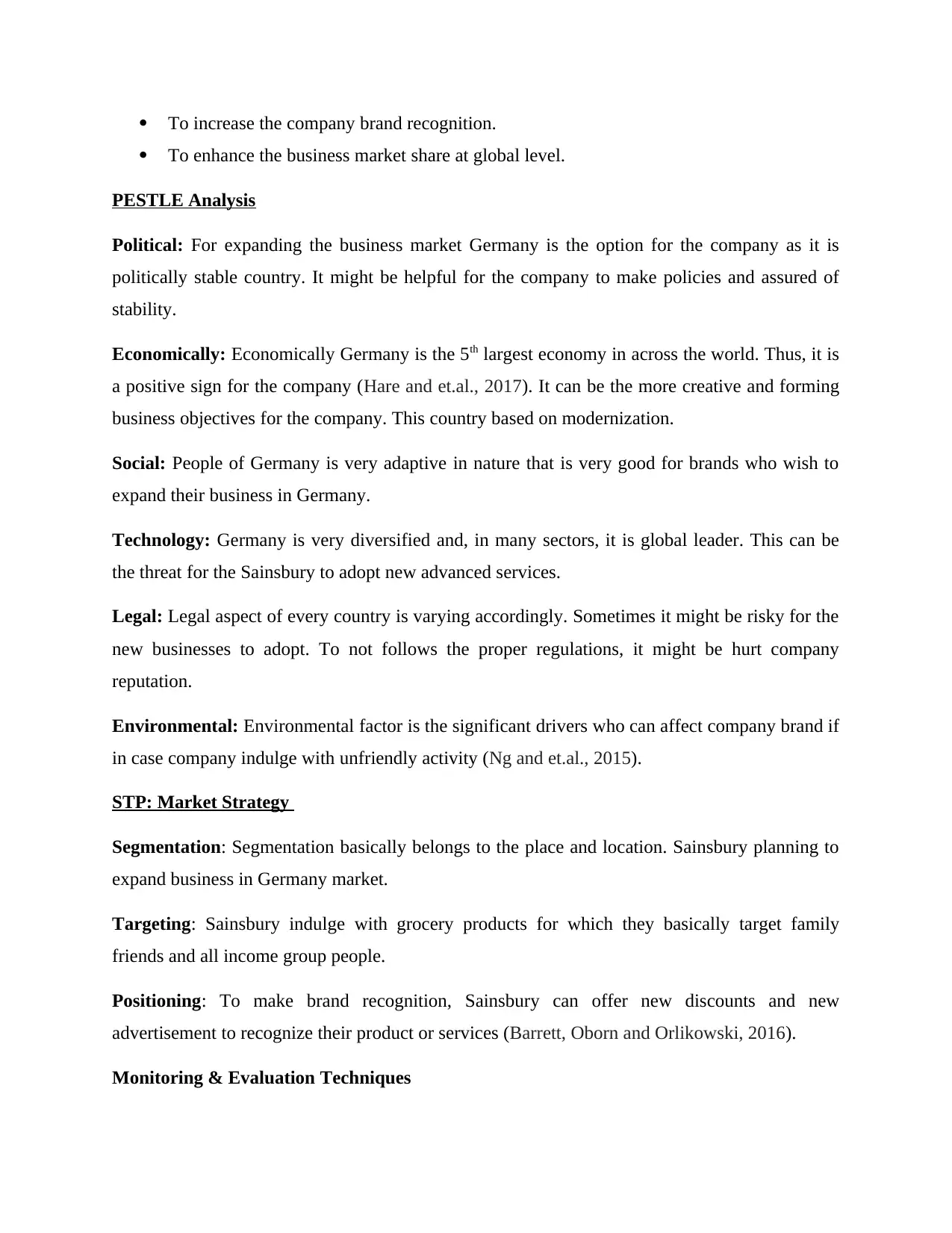
To increase the company brand recognition.
To enhance the business market share at global level.
PESTLE Analysis
Political: For expanding the business market Germany is the option for the company as it is
politically stable country. It might be helpful for the company to make policies and assured of
stability.
Economically: Economically Germany is the 5th largest economy in across the world. Thus, it is
a positive sign for the company (Hare and et.al., 2017). It can be the more creative and forming
business objectives for the company. This country based on modernization.
Social: People of Germany is very adaptive in nature that is very good for brands who wish to
expand their business in Germany.
Technology: Germany is very diversified and, in many sectors, it is global leader. This can be
the threat for the Sainsbury to adopt new advanced services.
Legal: Legal aspect of every country is varying accordingly. Sometimes it might be risky for the
new businesses to adopt. To not follows the proper regulations, it might be hurt company
reputation.
Environmental: Environmental factor is the significant drivers who can affect company brand if
in case company indulge with unfriendly activity (Ng and et.al., 2015).
STP: Market Strategy
Segmentation: Segmentation basically belongs to the place and location. Sainsbury planning to
expand business in Germany market.
Targeting: Sainsbury indulge with grocery products for which they basically target family
friends and all income group people.
Positioning: To make brand recognition, Sainsbury can offer new discounts and new
advertisement to recognize their product or services (Barrett, Oborn and Orlikowski, 2016).
Monitoring & Evaluation Techniques
To enhance the business market share at global level.
PESTLE Analysis
Political: For expanding the business market Germany is the option for the company as it is
politically stable country. It might be helpful for the company to make policies and assured of
stability.
Economically: Economically Germany is the 5th largest economy in across the world. Thus, it is
a positive sign for the company (Hare and et.al., 2017). It can be the more creative and forming
business objectives for the company. This country based on modernization.
Social: People of Germany is very adaptive in nature that is very good for brands who wish to
expand their business in Germany.
Technology: Germany is very diversified and, in many sectors, it is global leader. This can be
the threat for the Sainsbury to adopt new advanced services.
Legal: Legal aspect of every country is varying accordingly. Sometimes it might be risky for the
new businesses to adopt. To not follows the proper regulations, it might be hurt company
reputation.
Environmental: Environmental factor is the significant drivers who can affect company brand if
in case company indulge with unfriendly activity (Ng and et.al., 2015).
STP: Market Strategy
Segmentation: Segmentation basically belongs to the place and location. Sainsbury planning to
expand business in Germany market.
Targeting: Sainsbury indulge with grocery products for which they basically target family
friends and all income group people.
Positioning: To make brand recognition, Sainsbury can offer new discounts and new
advertisement to recognize their product or services (Barrett, Oborn and Orlikowski, 2016).
Monitoring & Evaluation Techniques

Feedback from employees or customers: To get review or check how much new plan
will be implemented properly. Get feedback from employee or customer is the best way to make
further corrections.
Evaluate performance management: Review actual performance with desired results to
know much plan will be implemented in proper manner. It helps to review the whole plan.
CONCLUSION
On the basis of above describing report it has been concluded, business strategy is the
most essential things that has to be done or implementing by the organization. Study defined
internal or external business factors to analyze the business market. In order to defined the aim of
the research study explored the business market analysis tools such as PESTLE and SWOT
analysis. In order to evaue the different types of strategic directions study explained the model
Ansoff matrix model where the report explained that the for-company Market Penetration is the
best option for the company to carry out the results. Also, study justified the current reason of
choosing business results. At the end of the report segment study also produced the new strategic
plan for the company development.
will be implemented properly. Get feedback from employee or customer is the best way to make
further corrections.
Evaluate performance management: Review actual performance with desired results to
know much plan will be implemented in proper manner. It helps to review the whole plan.
CONCLUSION
On the basis of above describing report it has been concluded, business strategy is the
most essential things that has to be done or implementing by the organization. Study defined
internal or external business factors to analyze the business market. In order to defined the aim of
the research study explored the business market analysis tools such as PESTLE and SWOT
analysis. In order to evaue the different types of strategic directions study explained the model
Ansoff matrix model where the report explained that the for-company Market Penetration is the
best option for the company to carry out the results. Also, study justified the current reason of
choosing business results. At the end of the report segment study also produced the new strategic
plan for the company development.
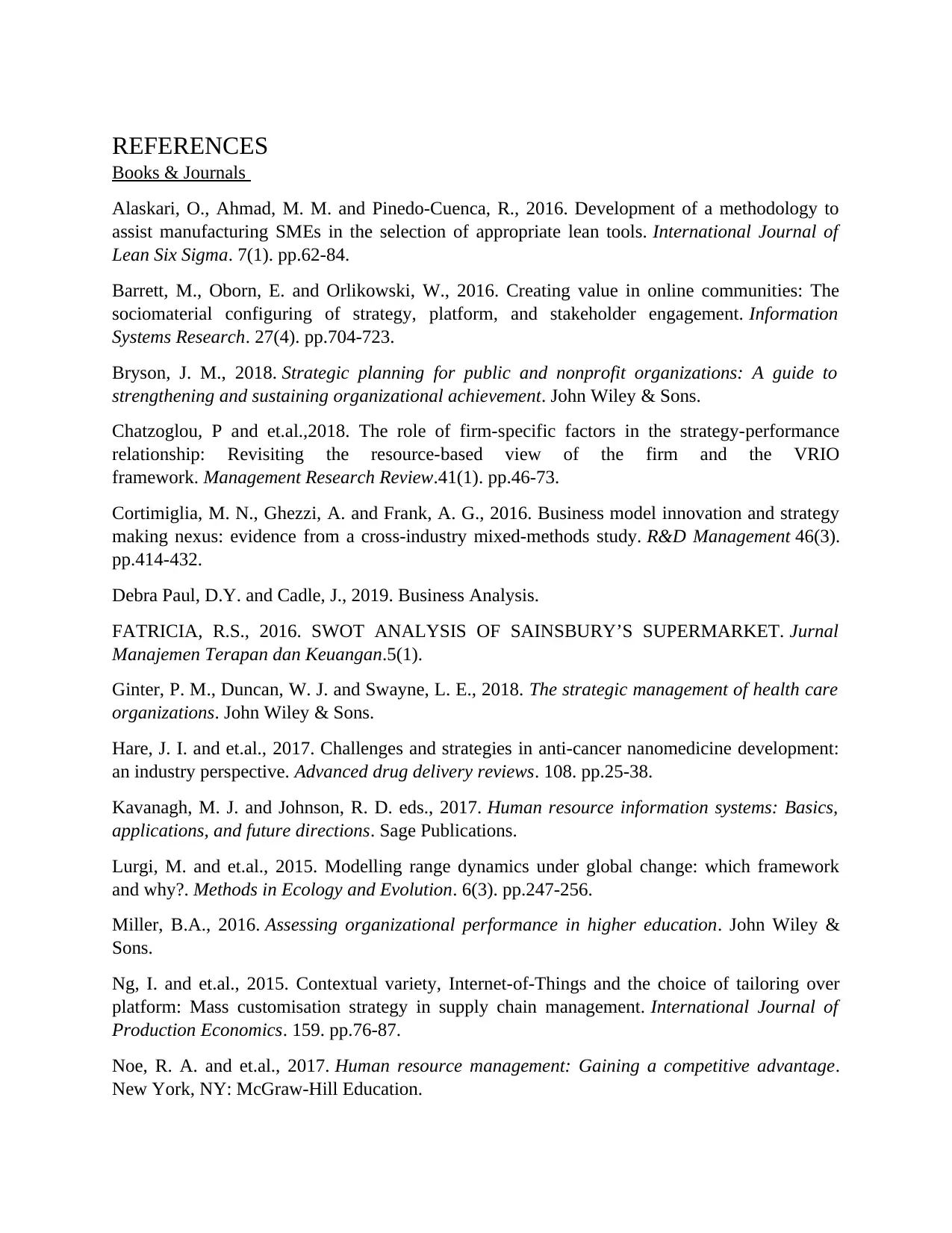
REFERENCES
Books & Journals
Alaskari, O., Ahmad, M. M. and Pinedo-Cuenca, R., 2016. Development of a methodology to
assist manufacturing SMEs in the selection of appropriate lean tools. International Journal of
Lean Six Sigma. 7(1). pp.62-84.
Barrett, M., Oborn, E. and Orlikowski, W., 2016. Creating value in online communities: The
sociomaterial configuring of strategy, platform, and stakeholder engagement. Information
Systems Research. 27(4). pp.704-723.
Bryson, J. M., 2018. Strategic planning for public and nonprofit organizations: A guide to
strengthening and sustaining organizational achievement. John Wiley & Sons.
Chatzoglou, P and et.al.,2018. The role of firm-specific factors in the strategy-performance
relationship: Revisiting the resource-based view of the firm and the VRIO
framework. Management Research Review.41(1). pp.46-73.
Cortimiglia, M. N., Ghezzi, A. and Frank, A. G., 2016. Business model innovation and strategy
making nexus: evidence from a cross‐industry mixed‐methods study. R&D Management 46(3).
pp.414-432.
Debra Paul, D.Y. and Cadle, J., 2019. Business Analysis.
FATRICIA, R.S., 2016. SWOT ANALYSIS OF SAINSBURY’S SUPERMARKET. Jurnal
Manajemen Terapan dan Keuangan.5(1).
Ginter, P. M., Duncan, W. J. and Swayne, L. E., 2018. The strategic management of health care
organizations. John Wiley & Sons.
Hare, J. I. and et.al., 2017. Challenges and strategies in anti-cancer nanomedicine development:
an industry perspective. Advanced drug delivery reviews. 108. pp.25-38.
Kavanagh, M. J. and Johnson, R. D. eds., 2017. Human resource information systems: Basics,
applications, and future directions. Sage Publications.
Lurgi, M. and et.al., 2015. Modelling range dynamics under global change: which framework
and why?. Methods in Ecology and Evolution. 6(3). pp.247-256.
Miller, B.A., 2016. Assessing organizational performance in higher education. John Wiley &
Sons.
Ng, I. and et.al., 2015. Contextual variety, Internet-of-Things and the choice of tailoring over
platform: Mass customisation strategy in supply chain management. International Journal of
Production Economics. 159. pp.76-87.
Noe, R. A. and et.al., 2017. Human resource management: Gaining a competitive advantage.
New York, NY: McGraw-Hill Education.
Books & Journals
Alaskari, O., Ahmad, M. M. and Pinedo-Cuenca, R., 2016. Development of a methodology to
assist manufacturing SMEs in the selection of appropriate lean tools. International Journal of
Lean Six Sigma. 7(1). pp.62-84.
Barrett, M., Oborn, E. and Orlikowski, W., 2016. Creating value in online communities: The
sociomaterial configuring of strategy, platform, and stakeholder engagement. Information
Systems Research. 27(4). pp.704-723.
Bryson, J. M., 2018. Strategic planning for public and nonprofit organizations: A guide to
strengthening and sustaining organizational achievement. John Wiley & Sons.
Chatzoglou, P and et.al.,2018. The role of firm-specific factors in the strategy-performance
relationship: Revisiting the resource-based view of the firm and the VRIO
framework. Management Research Review.41(1). pp.46-73.
Cortimiglia, M. N., Ghezzi, A. and Frank, A. G., 2016. Business model innovation and strategy
making nexus: evidence from a cross‐industry mixed‐methods study. R&D Management 46(3).
pp.414-432.
Debra Paul, D.Y. and Cadle, J., 2019. Business Analysis.
FATRICIA, R.S., 2016. SWOT ANALYSIS OF SAINSBURY’S SUPERMARKET. Jurnal
Manajemen Terapan dan Keuangan.5(1).
Ginter, P. M., Duncan, W. J. and Swayne, L. E., 2018. The strategic management of health care
organizations. John Wiley & Sons.
Hare, J. I. and et.al., 2017. Challenges and strategies in anti-cancer nanomedicine development:
an industry perspective. Advanced drug delivery reviews. 108. pp.25-38.
Kavanagh, M. J. and Johnson, R. D. eds., 2017. Human resource information systems: Basics,
applications, and future directions. Sage Publications.
Lurgi, M. and et.al., 2015. Modelling range dynamics under global change: which framework
and why?. Methods in Ecology and Evolution. 6(3). pp.247-256.
Miller, B.A., 2016. Assessing organizational performance in higher education. John Wiley &
Sons.
Ng, I. and et.al., 2015. Contextual variety, Internet-of-Things and the choice of tailoring over
platform: Mass customisation strategy in supply chain management. International Journal of
Production Economics. 159. pp.76-87.
Noe, R. A. and et.al., 2017. Human resource management: Gaining a competitive advantage.
New York, NY: McGraw-Hill Education.
Secure Best Marks with AI Grader
Need help grading? Try our AI Grader for instant feedback on your assignments.

Proskuryakova, L., Meissner, D. and Rudnik, P., 2017. The use of technology platforms as a
policy tool to address research challenges and technology transfer. The Journal of Technology
Transfer. 42(1). pp.206-227.
Punt, A. E. and et.al., 2016. Management strategy evaluation: best practices. Fish and
Fisheries, 17(2), pp.303-334.
Rothaermel, F. T., 2017. Strategic management. New York, NY: McGraw-Hill Education.
Sanghi, S., 2016. The handbook of competency mapping: understanding, designing and
implementing competency models in organizations. SAGE publications India.
Steiss, A. W., 2019. Strategic management for public and nonprofit organizations. Routledge.
Thompson, J. and McLarney, C., 2017. What effects will the strategy changes undertaken by
next Plc have on themselves and their competition in the UK Clothing Retail Market?. Journal
of Commerce and Management Thought.8(2). p.234.
policy tool to address research challenges and technology transfer. The Journal of Technology
Transfer. 42(1). pp.206-227.
Punt, A. E. and et.al., 2016. Management strategy evaluation: best practices. Fish and
Fisheries, 17(2), pp.303-334.
Rothaermel, F. T., 2017. Strategic management. New York, NY: McGraw-Hill Education.
Sanghi, S., 2016. The handbook of competency mapping: understanding, designing and
implementing competency models in organizations. SAGE publications India.
Steiss, A. W., 2019. Strategic management for public and nonprofit organizations. Routledge.
Thompson, J. and McLarney, C., 2017. What effects will the strategy changes undertaken by
next Plc have on themselves and their competition in the UK Clothing Retail Market?. Journal
of Commerce and Management Thought.8(2). p.234.

1 out of 18
Related Documents
Your All-in-One AI-Powered Toolkit for Academic Success.
+13062052269
info@desklib.com
Available 24*7 on WhatsApp / Email
![[object Object]](/_next/static/media/star-bottom.7253800d.svg)
Unlock your academic potential
© 2024 | Zucol Services PVT LTD | All rights reserved.





